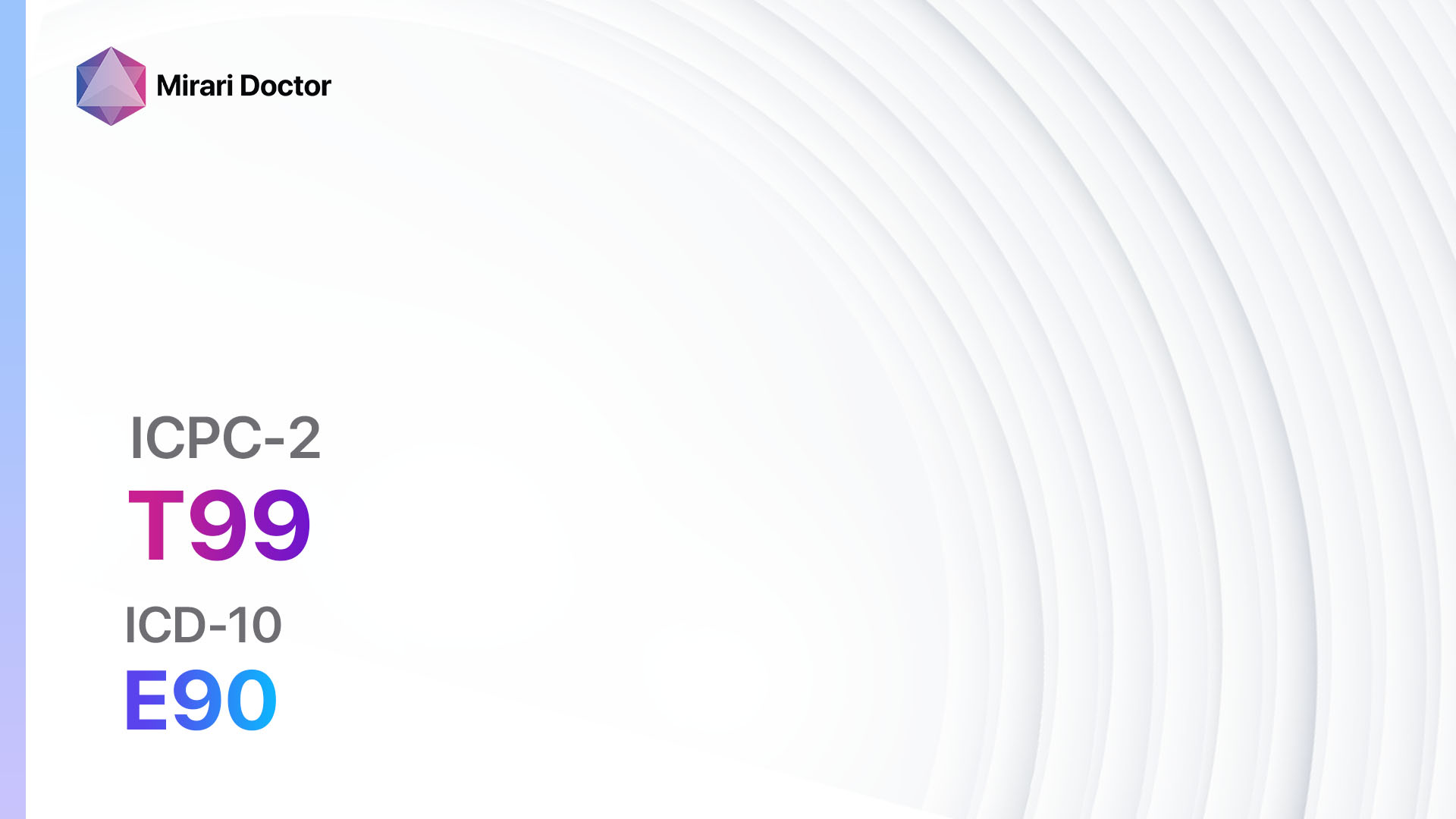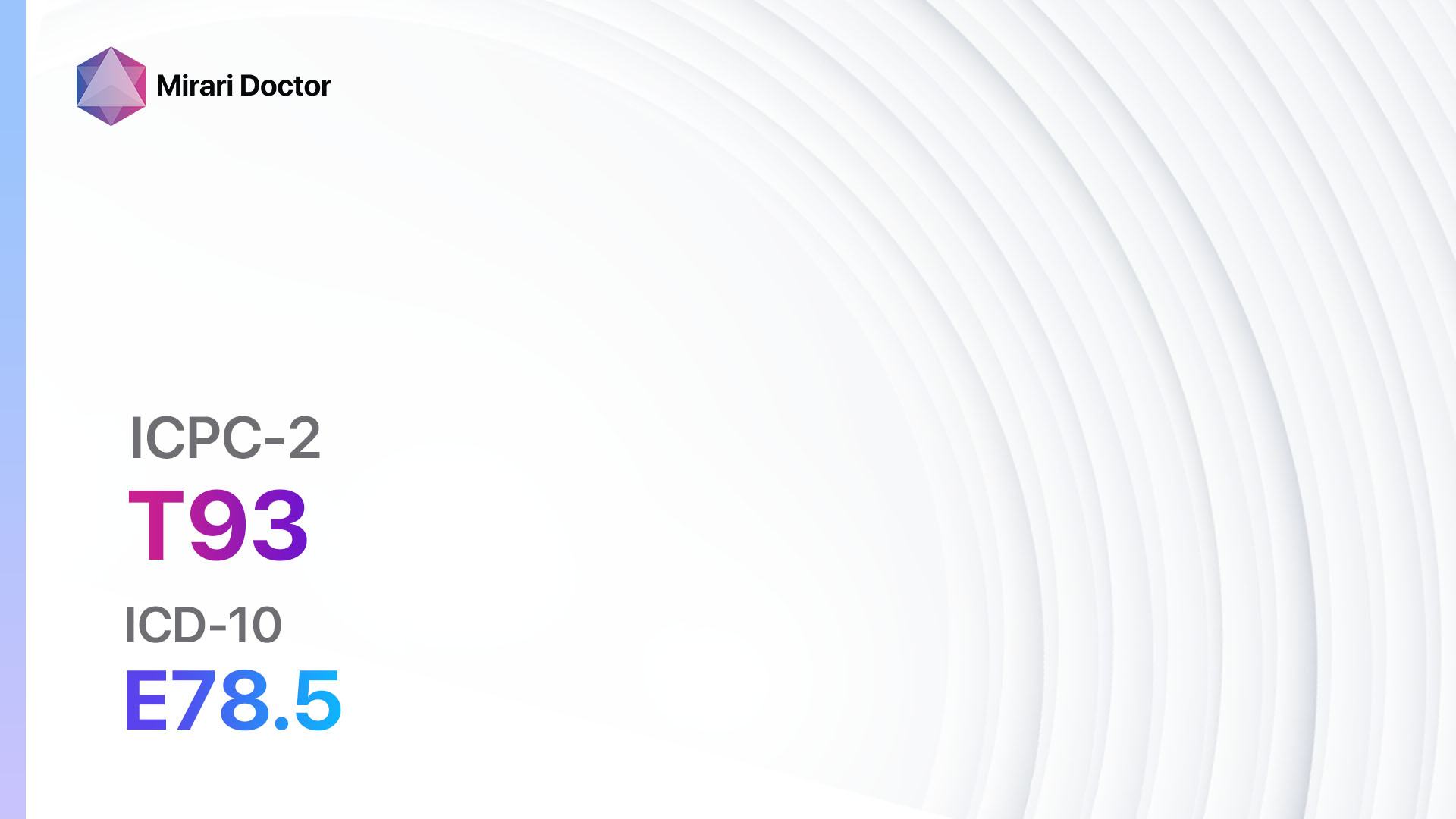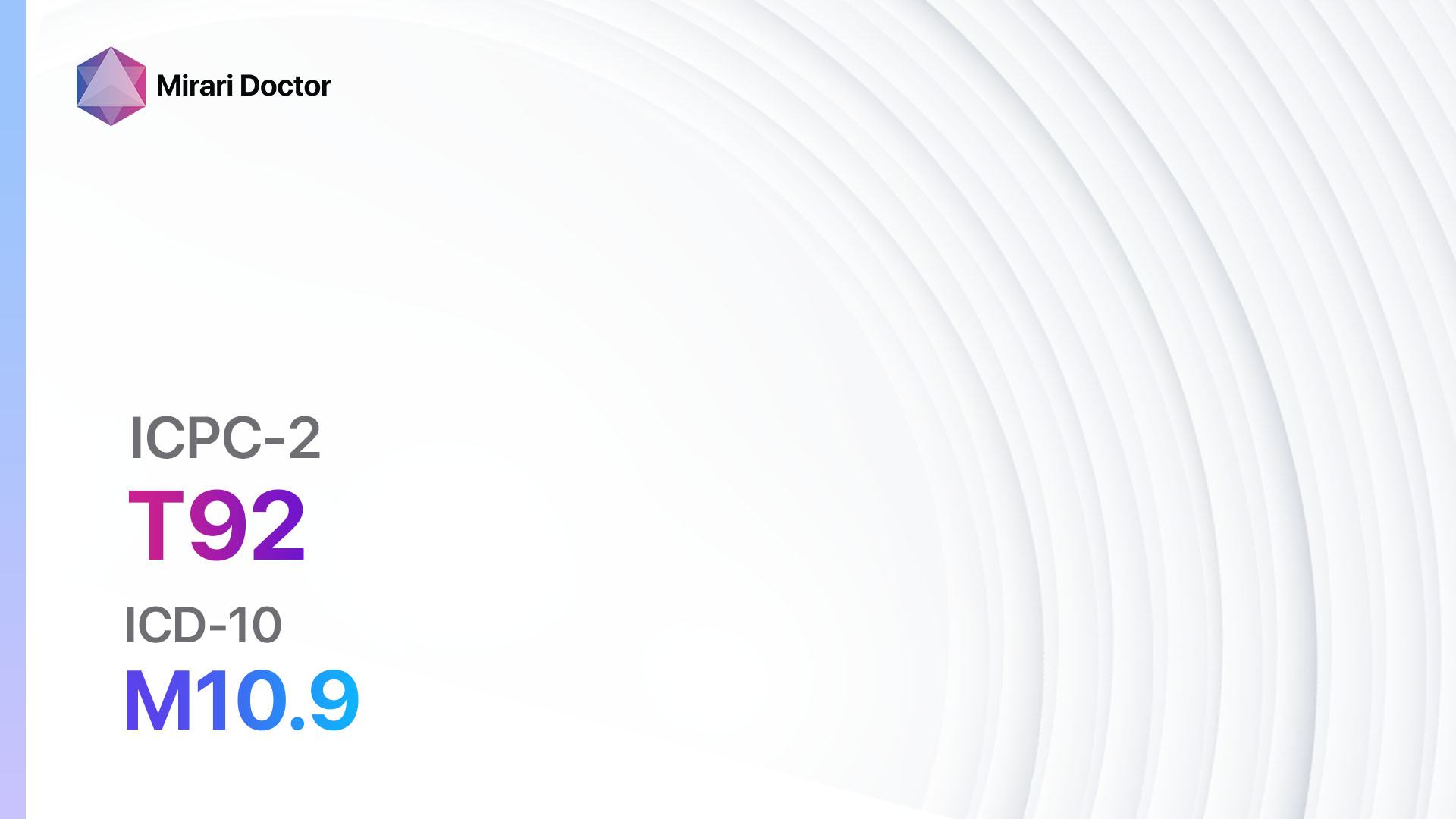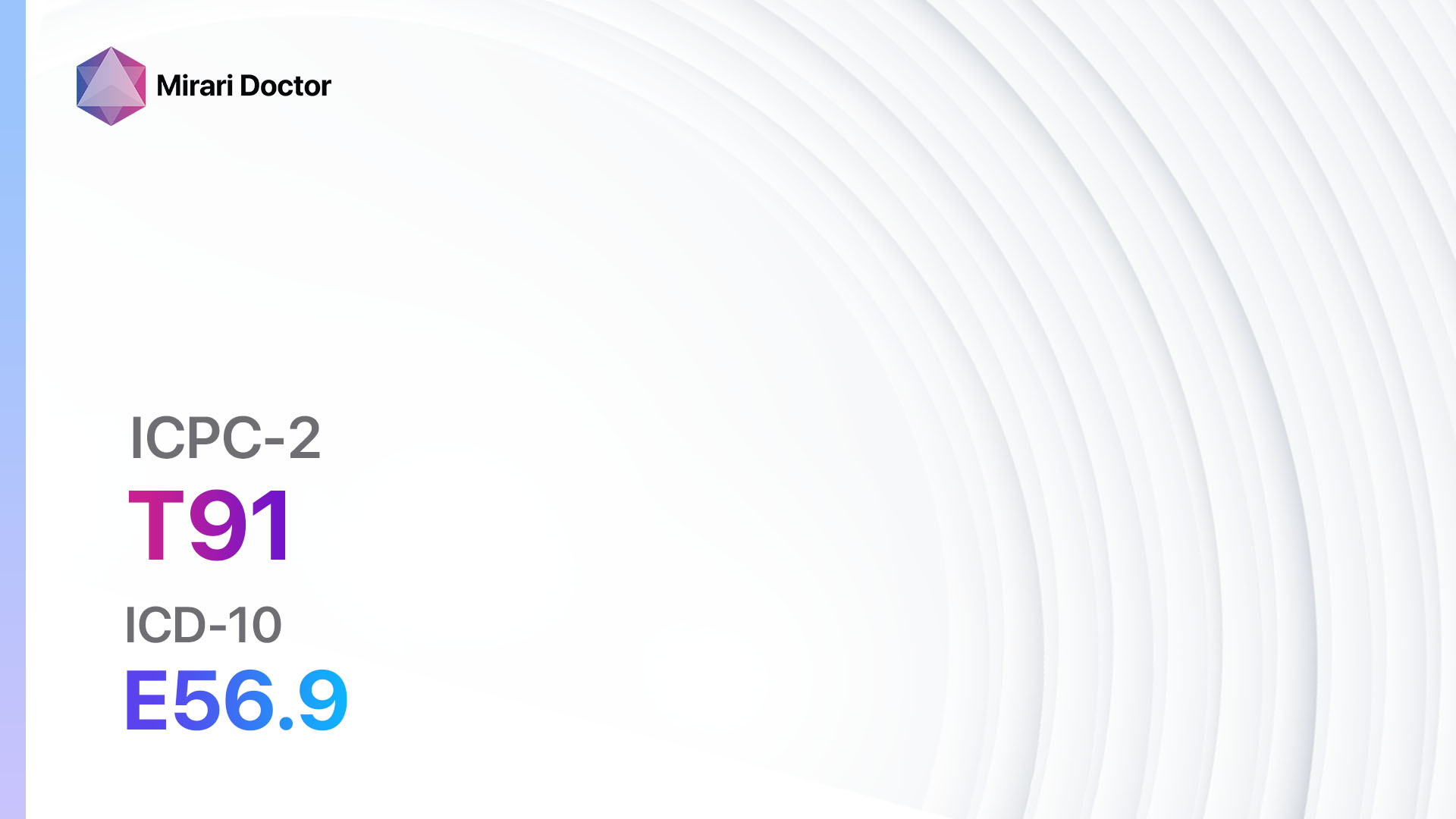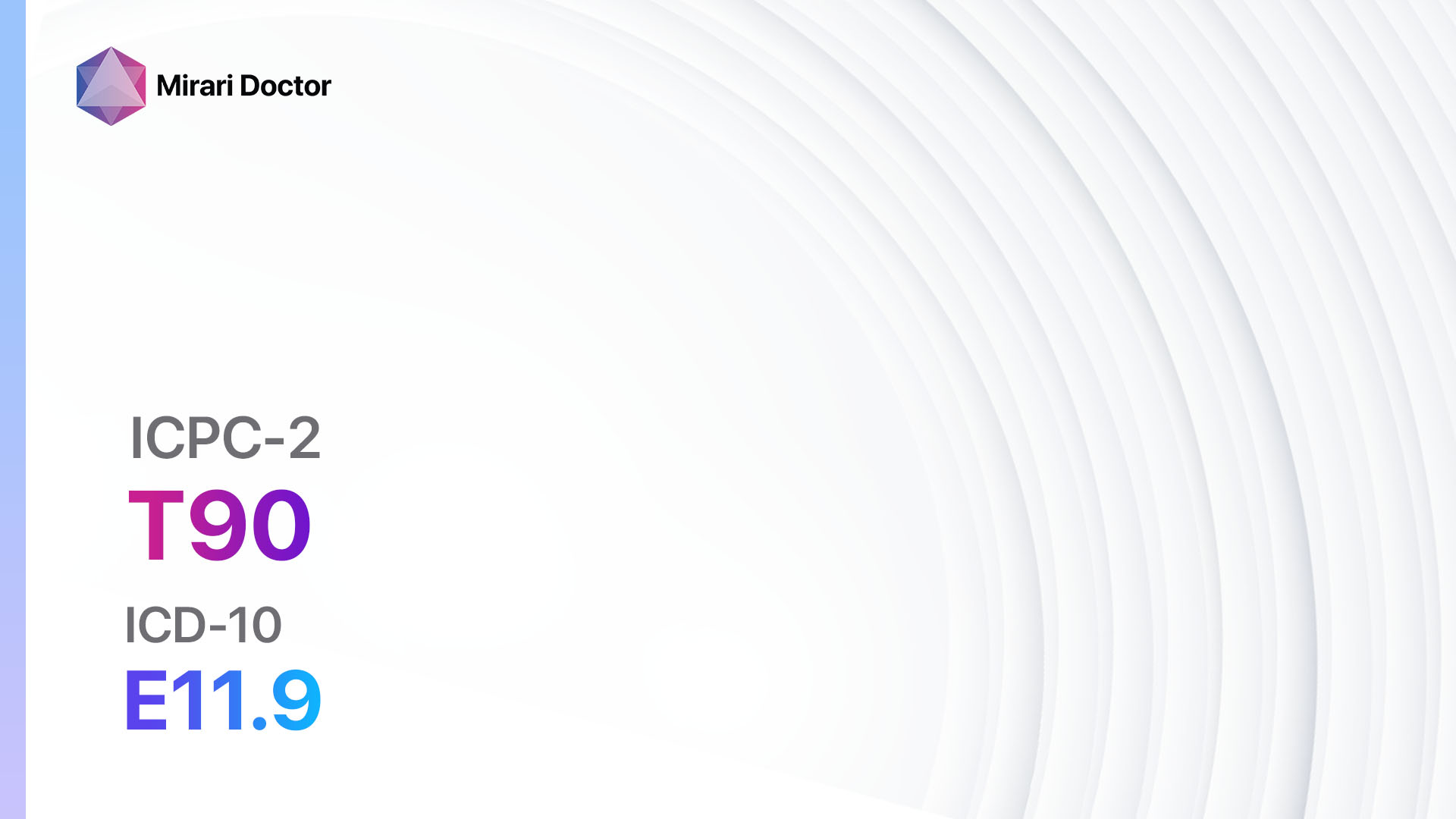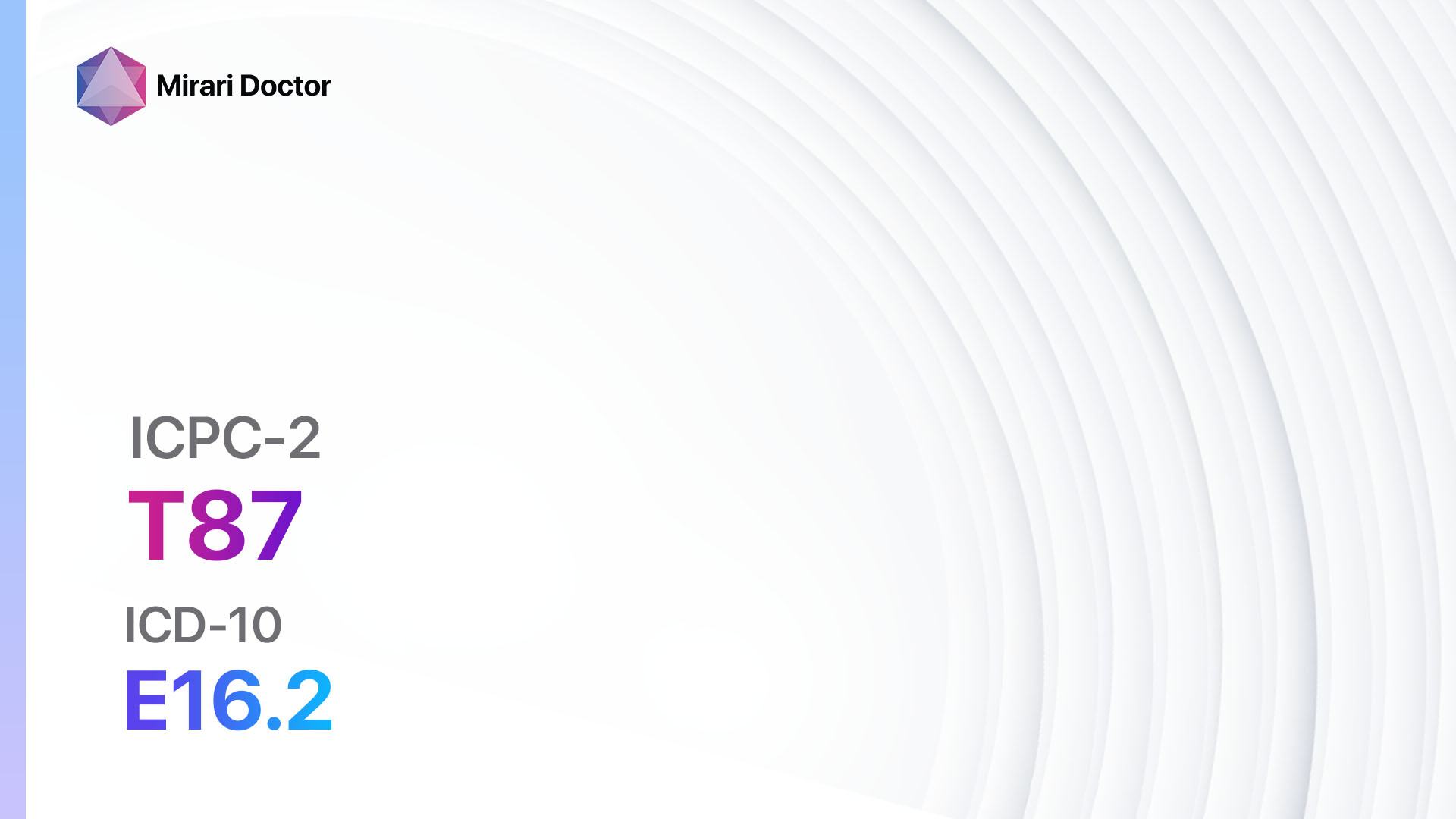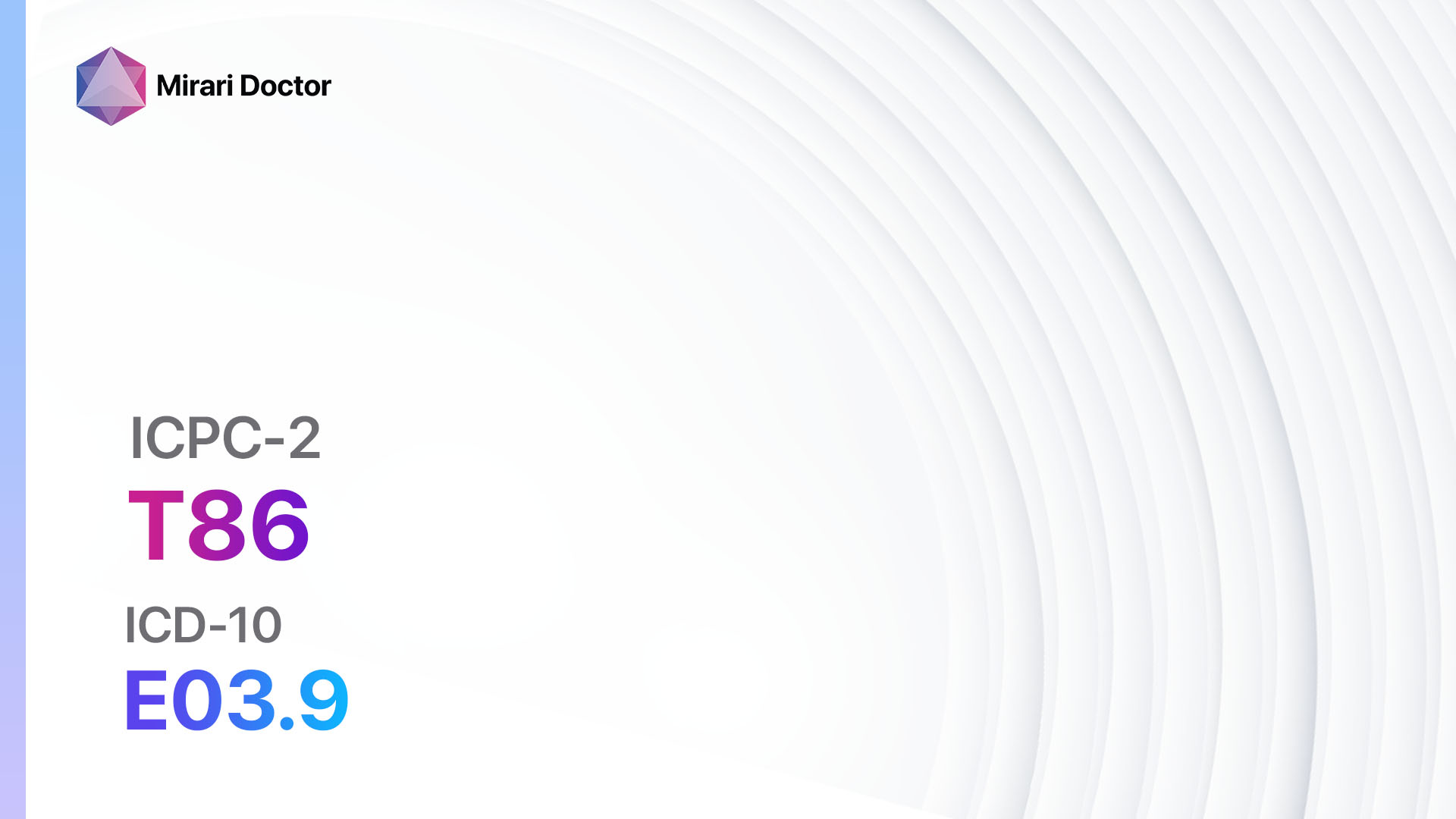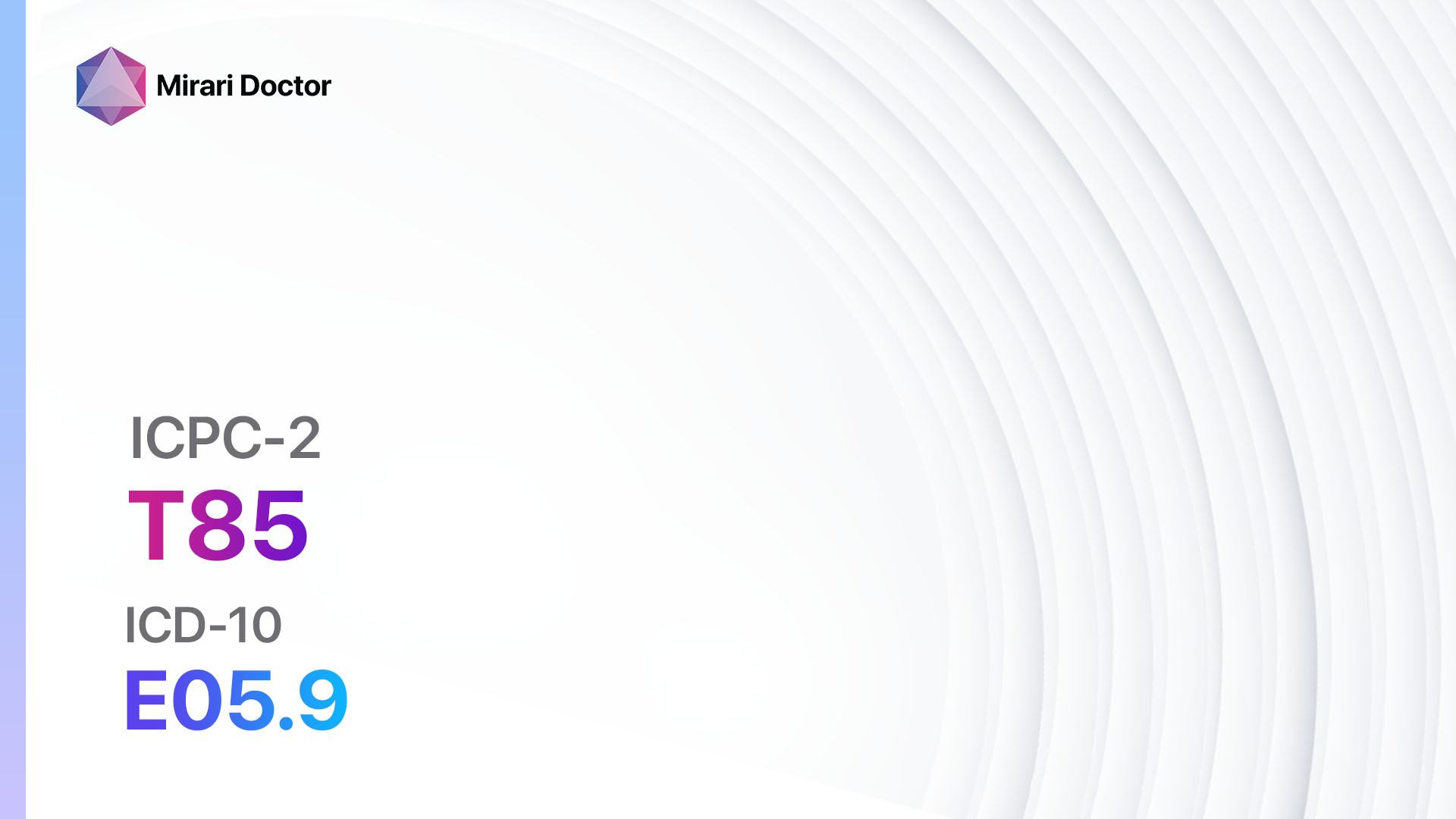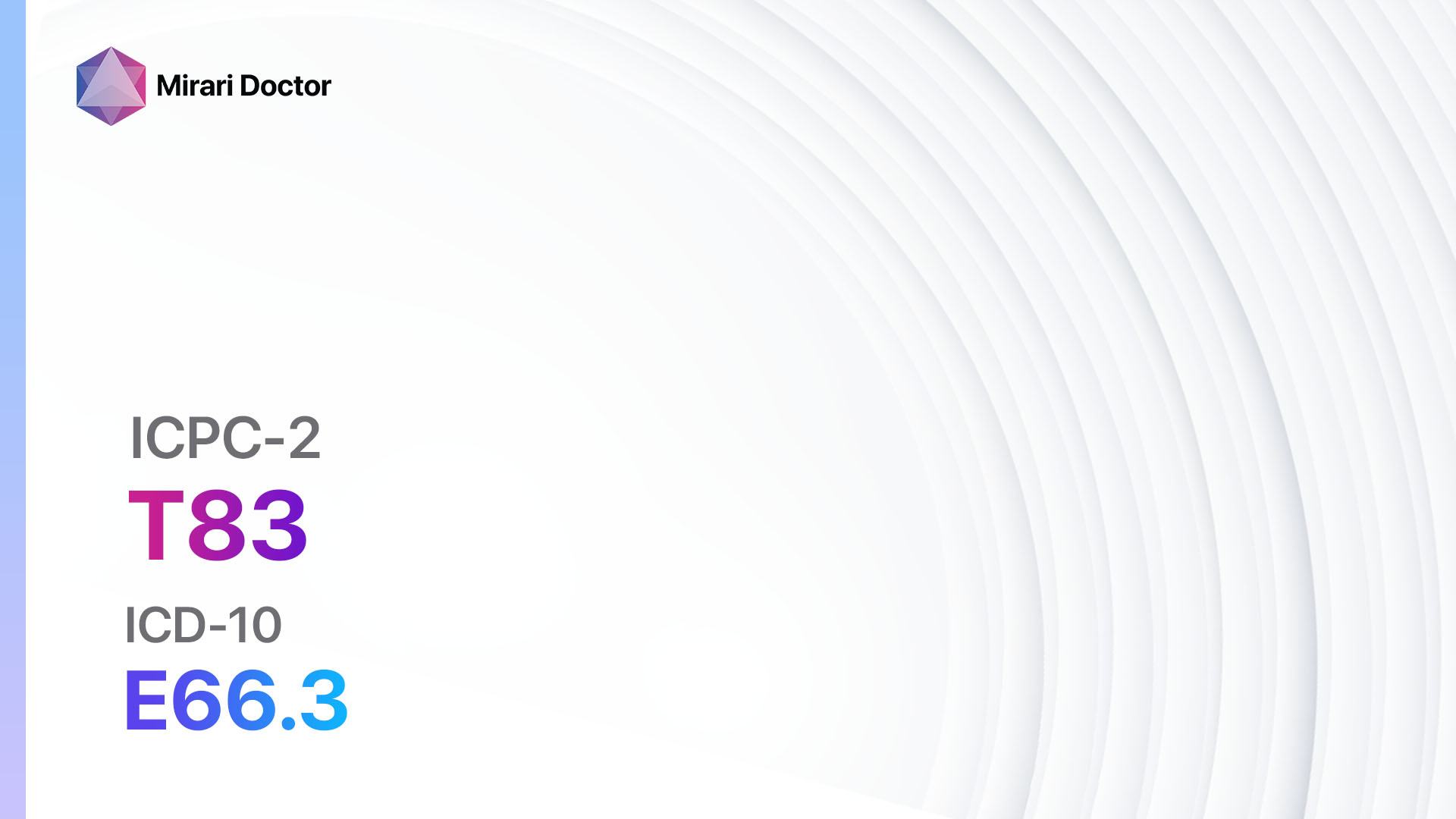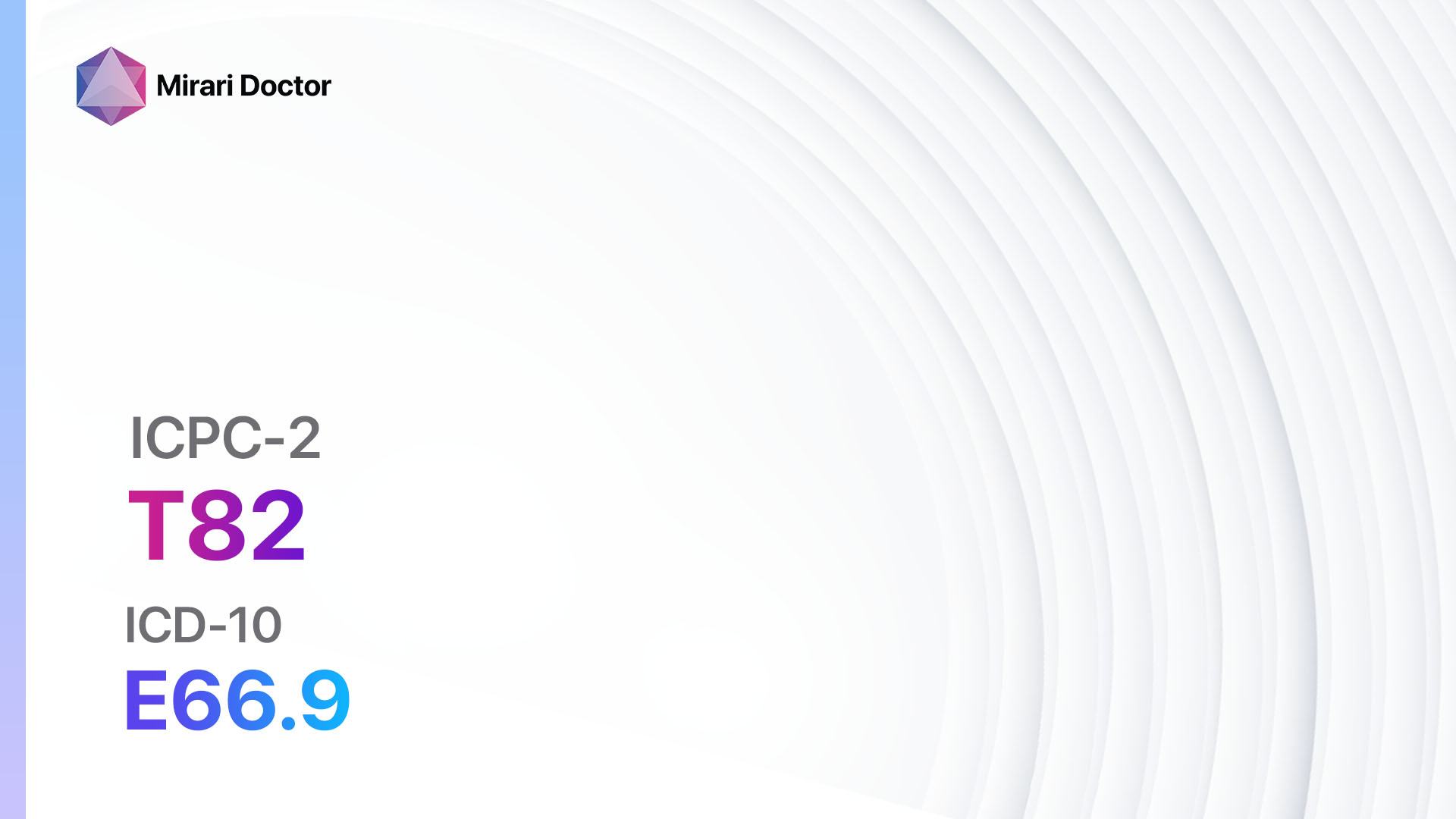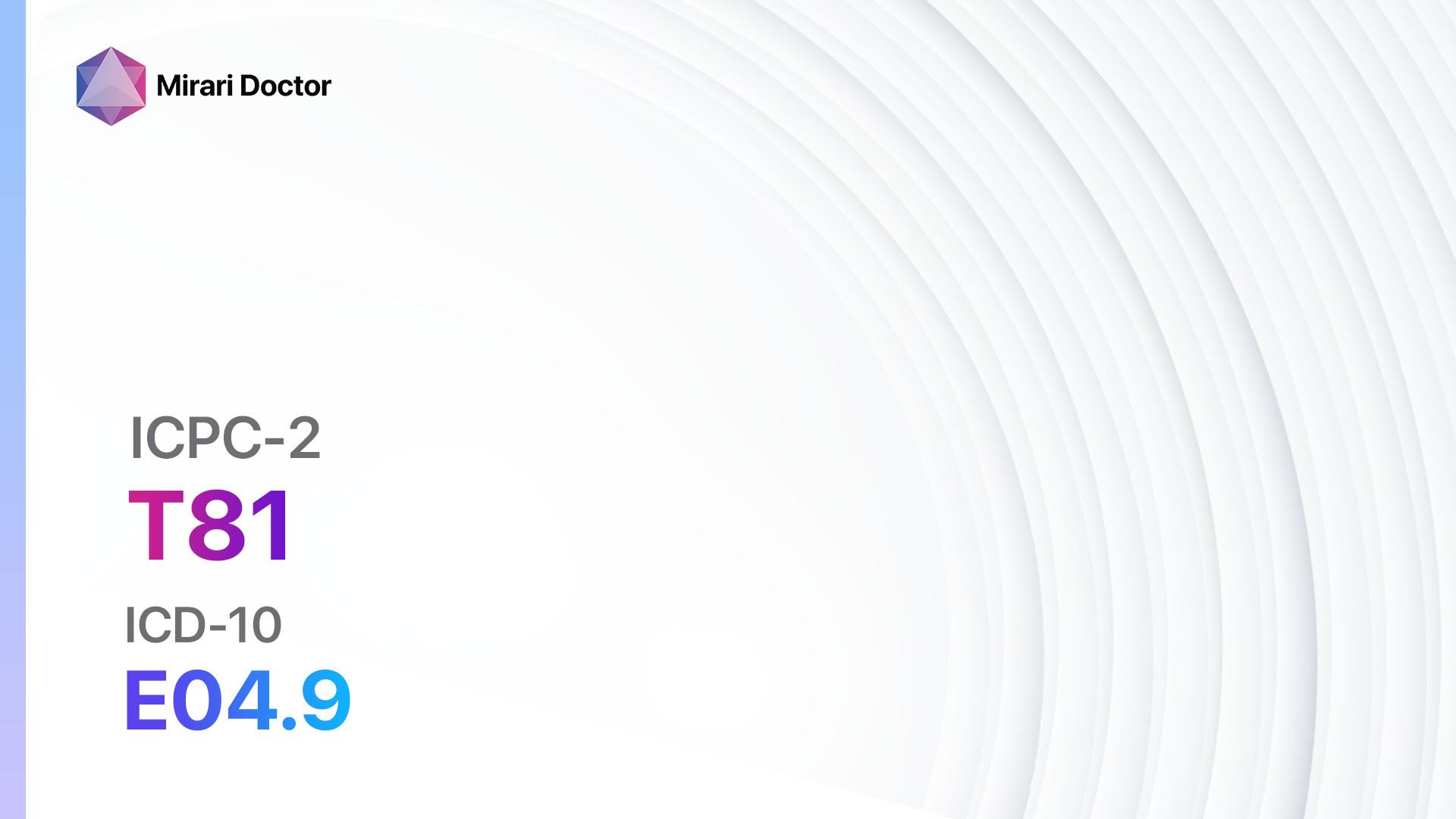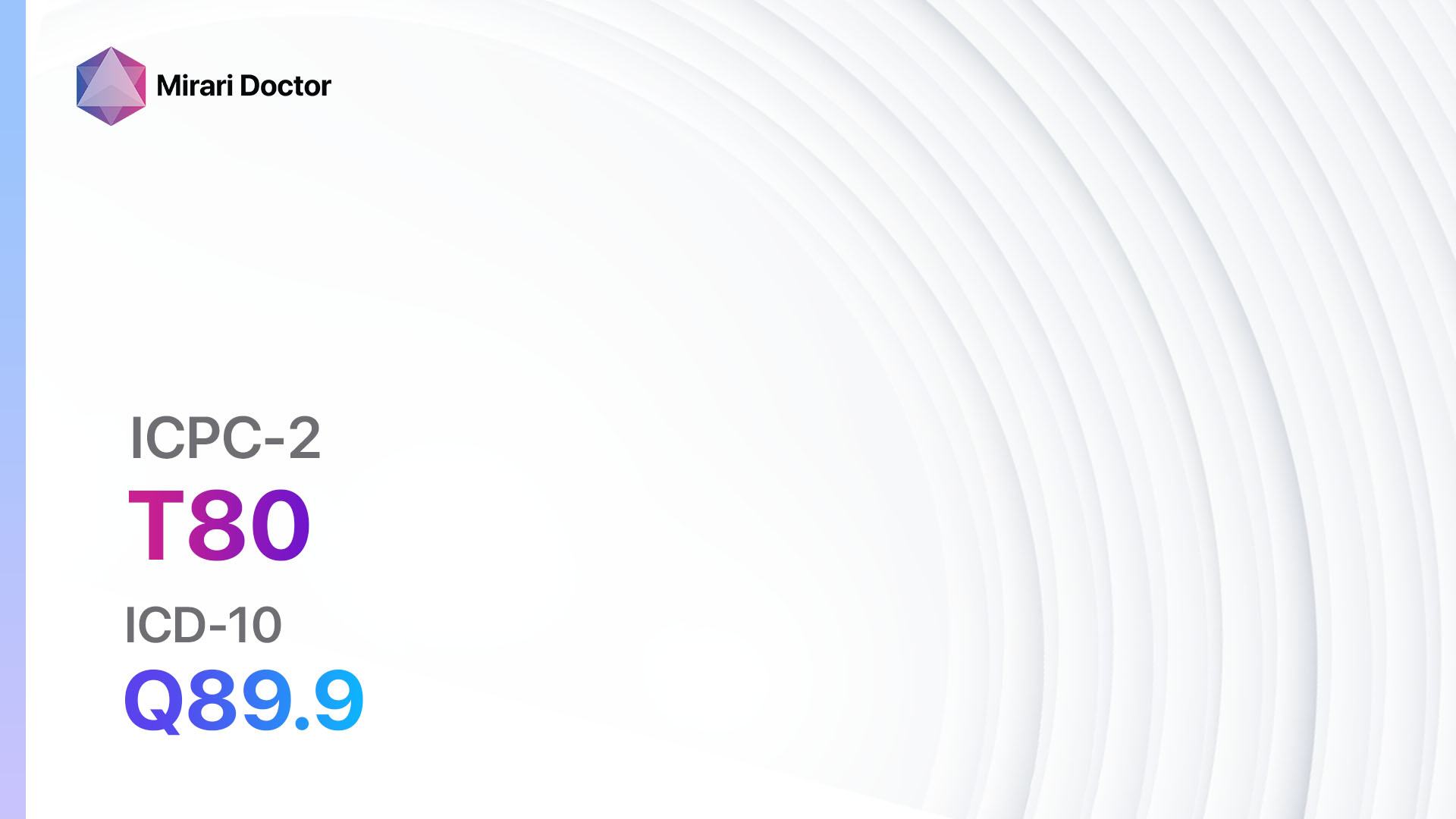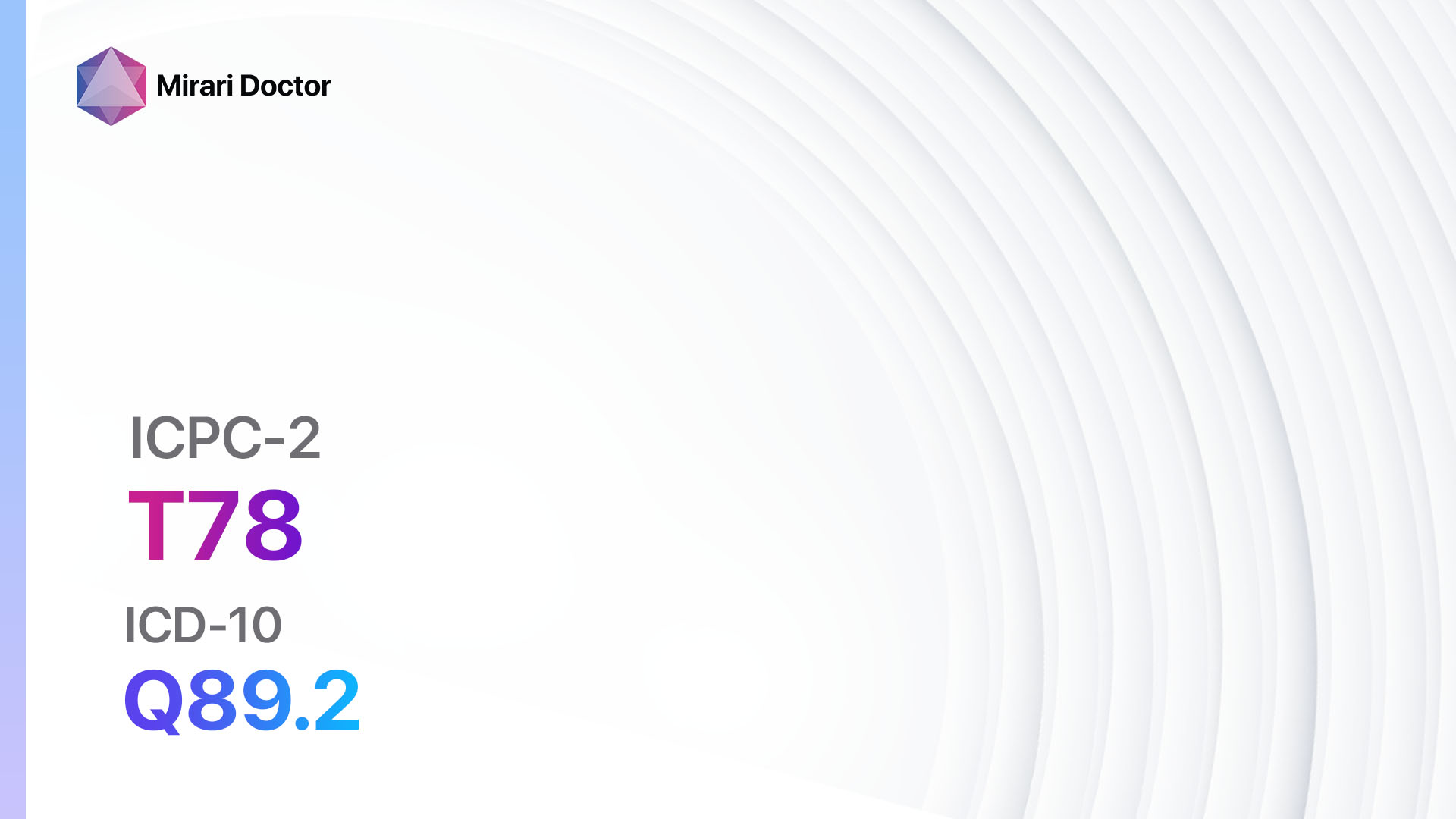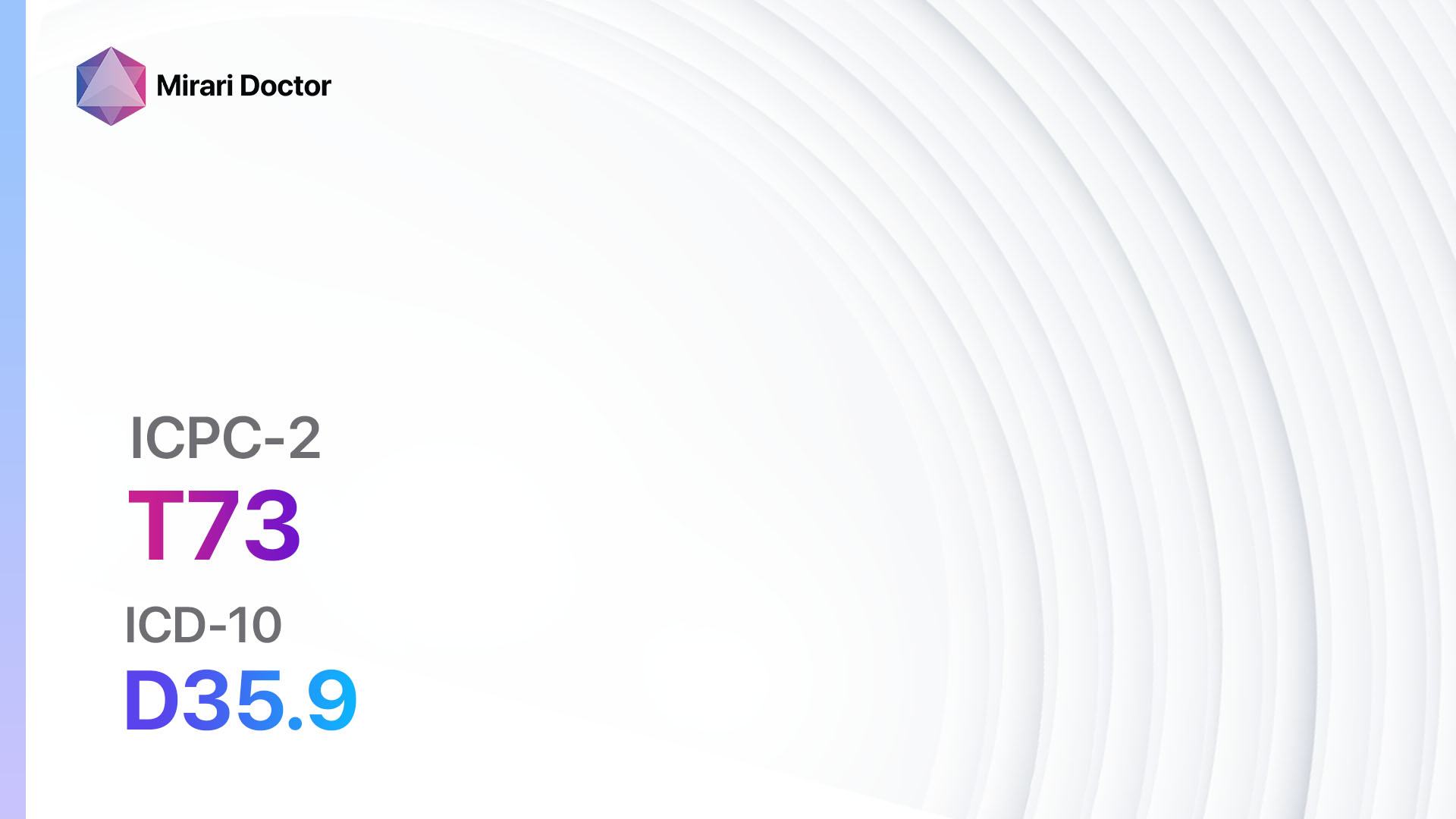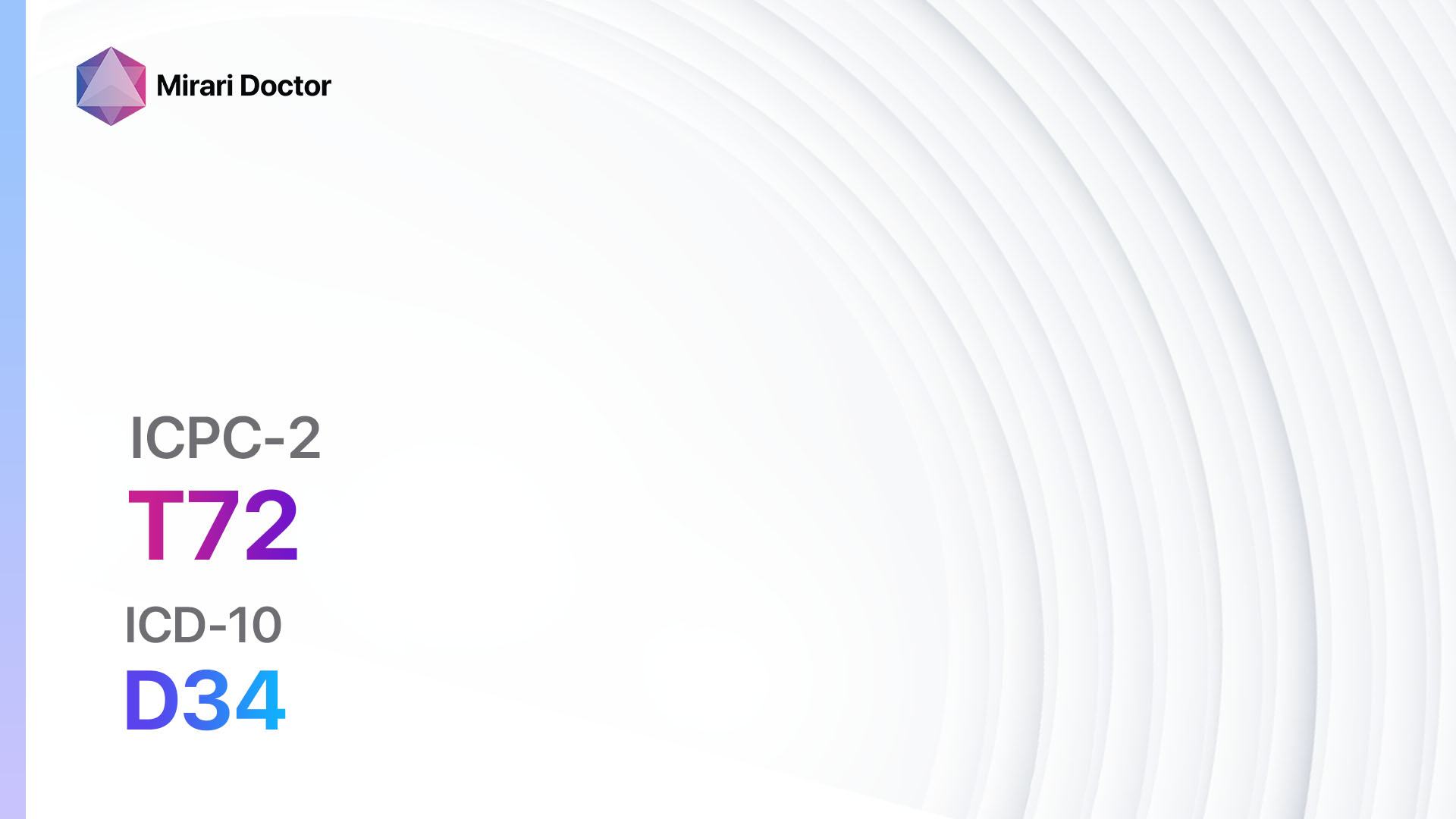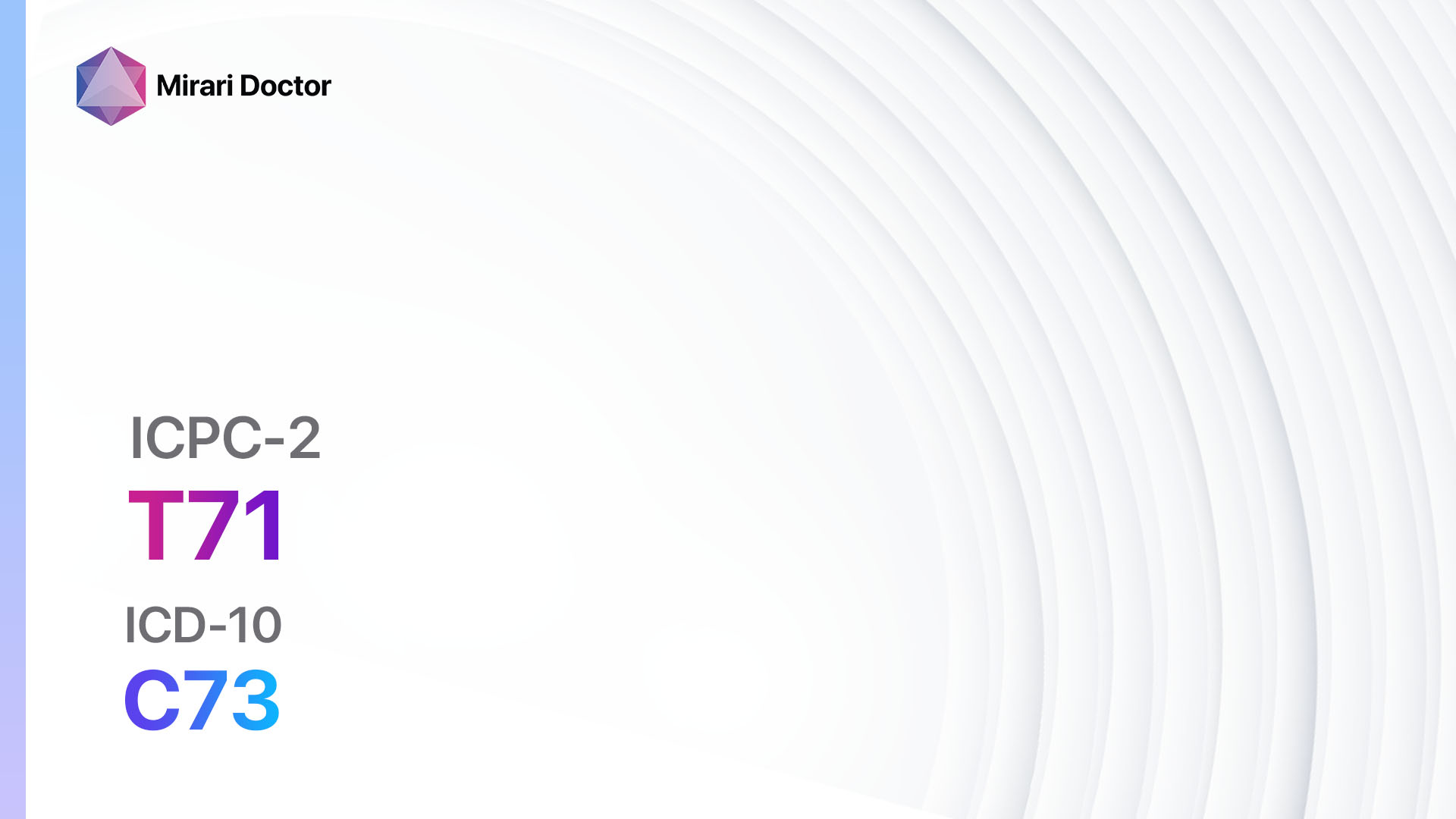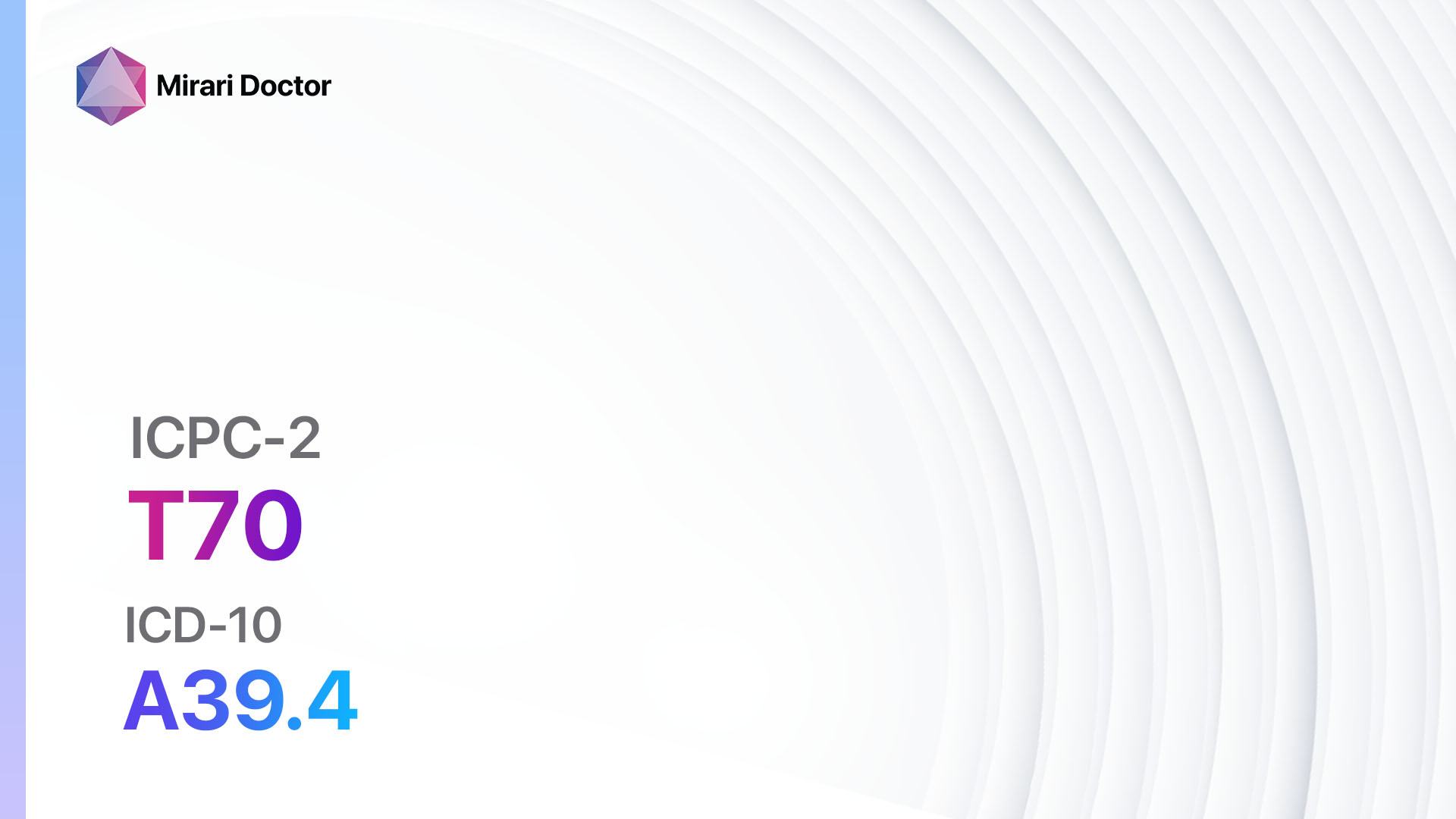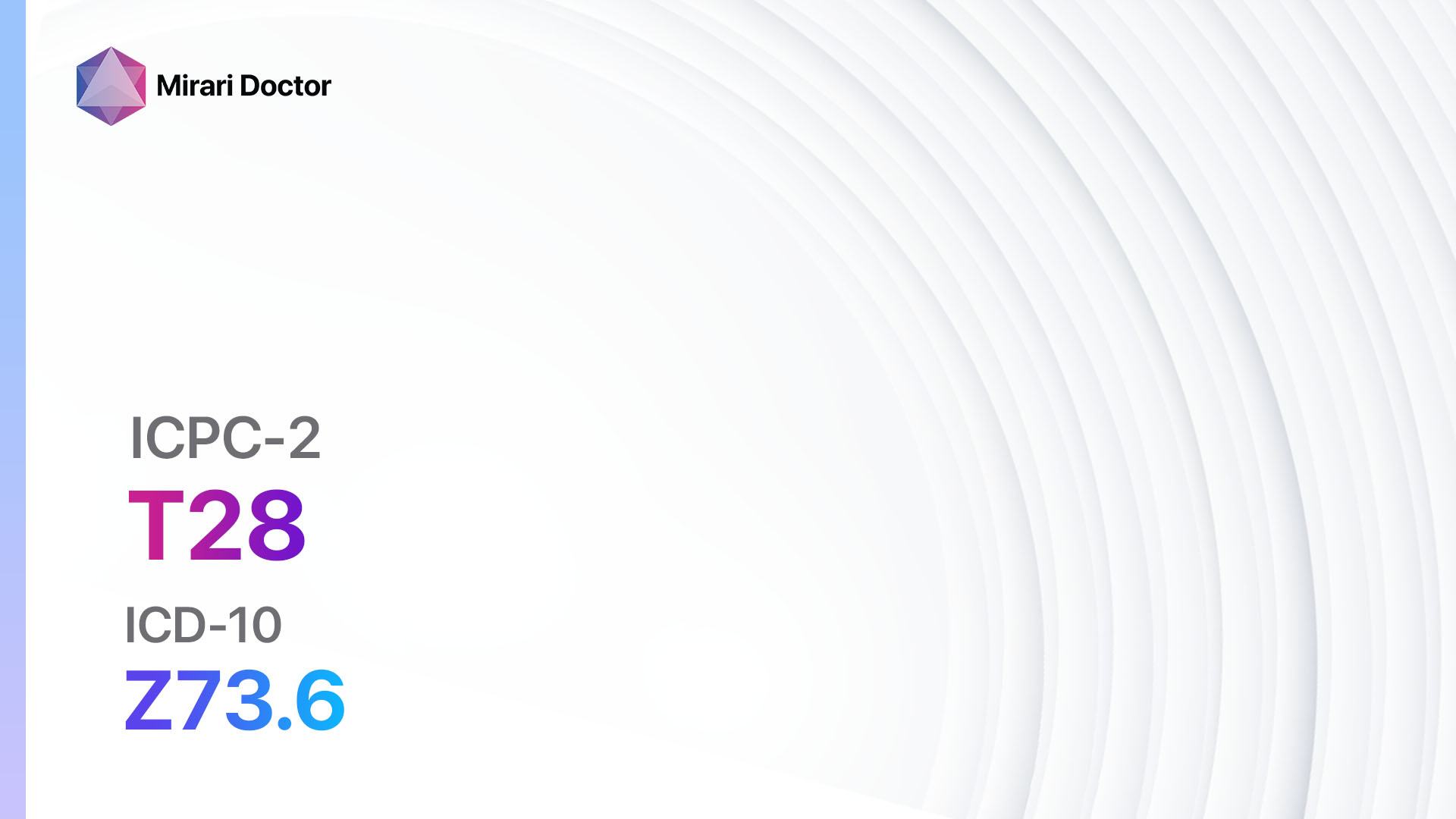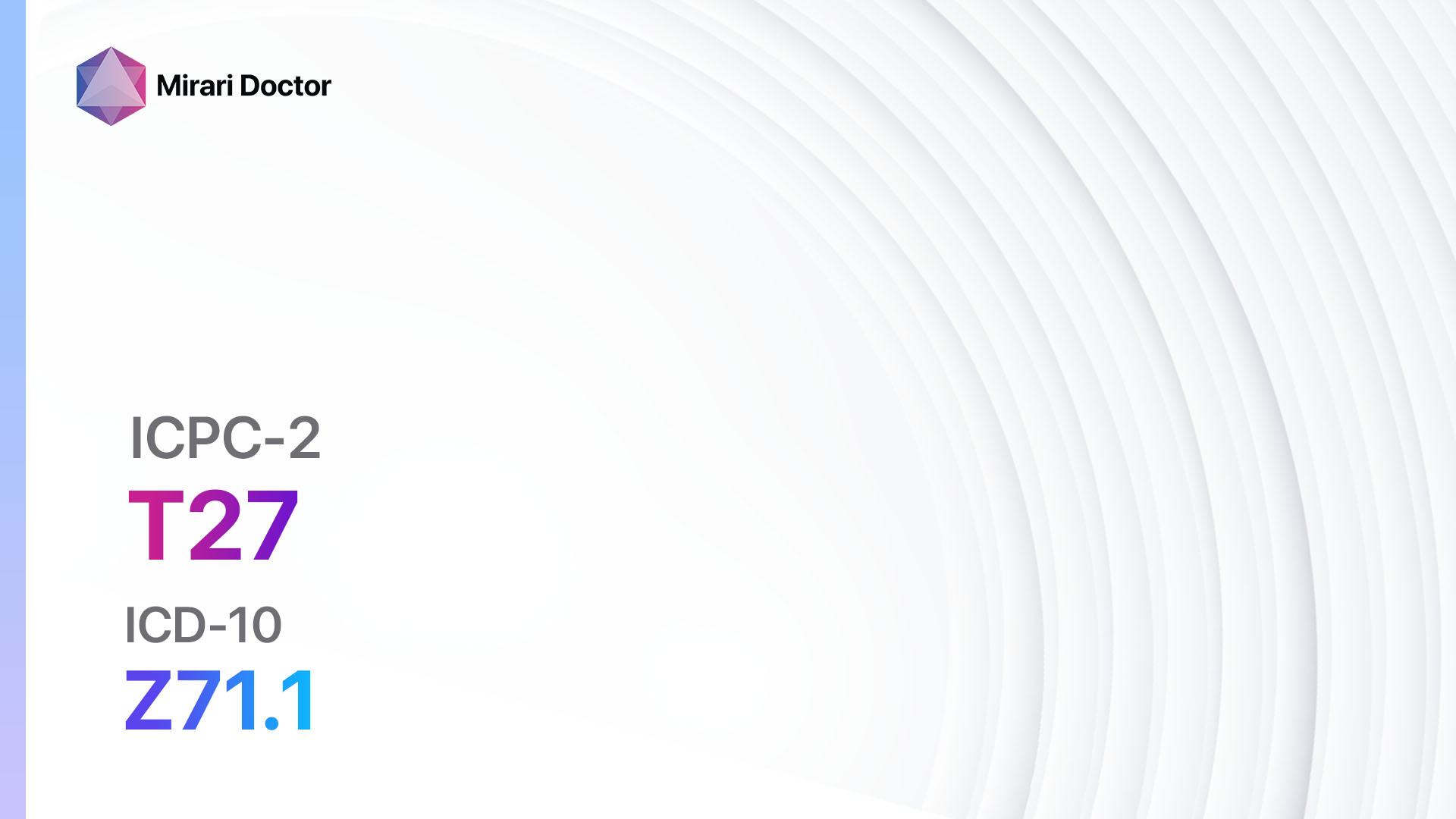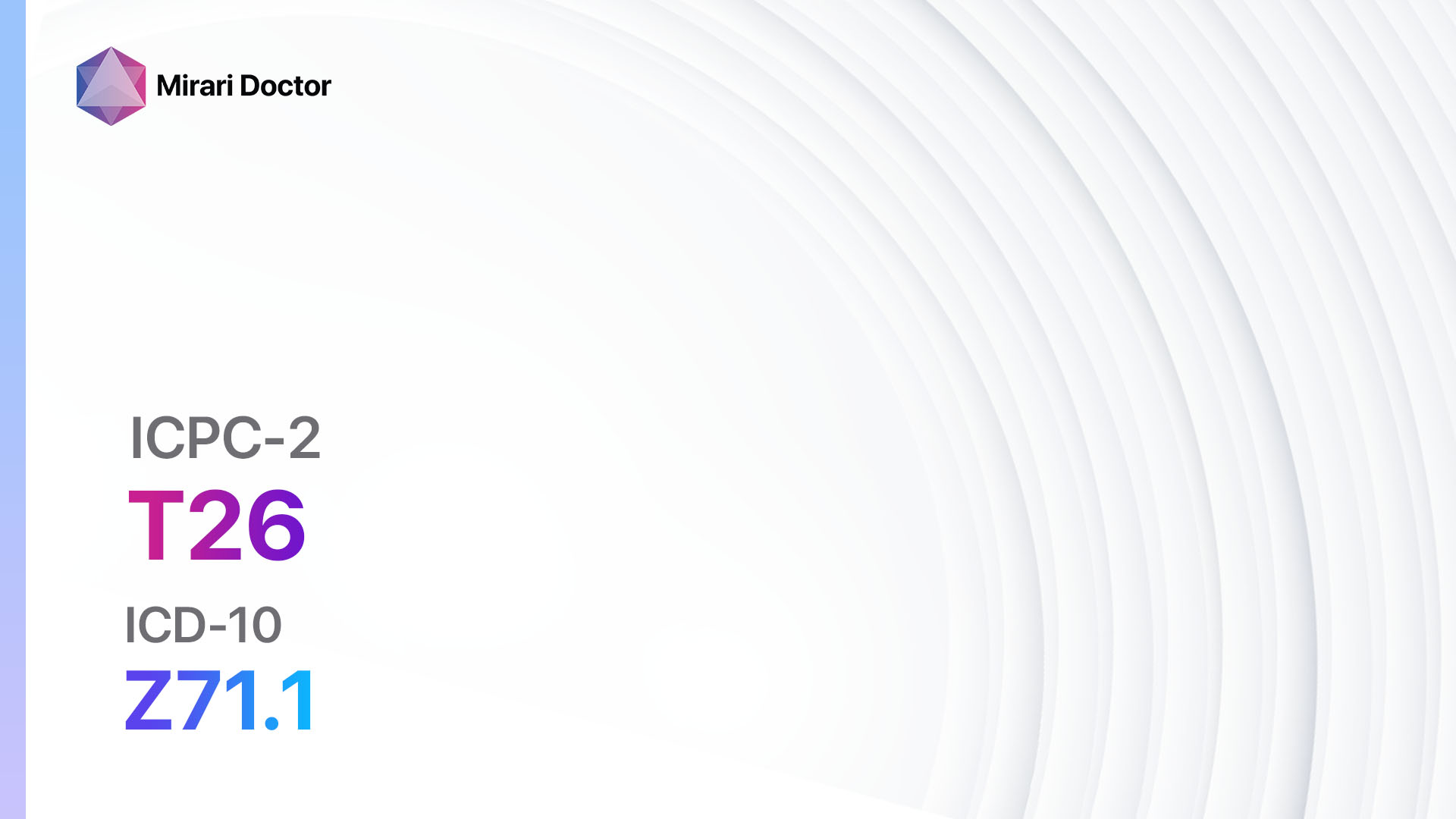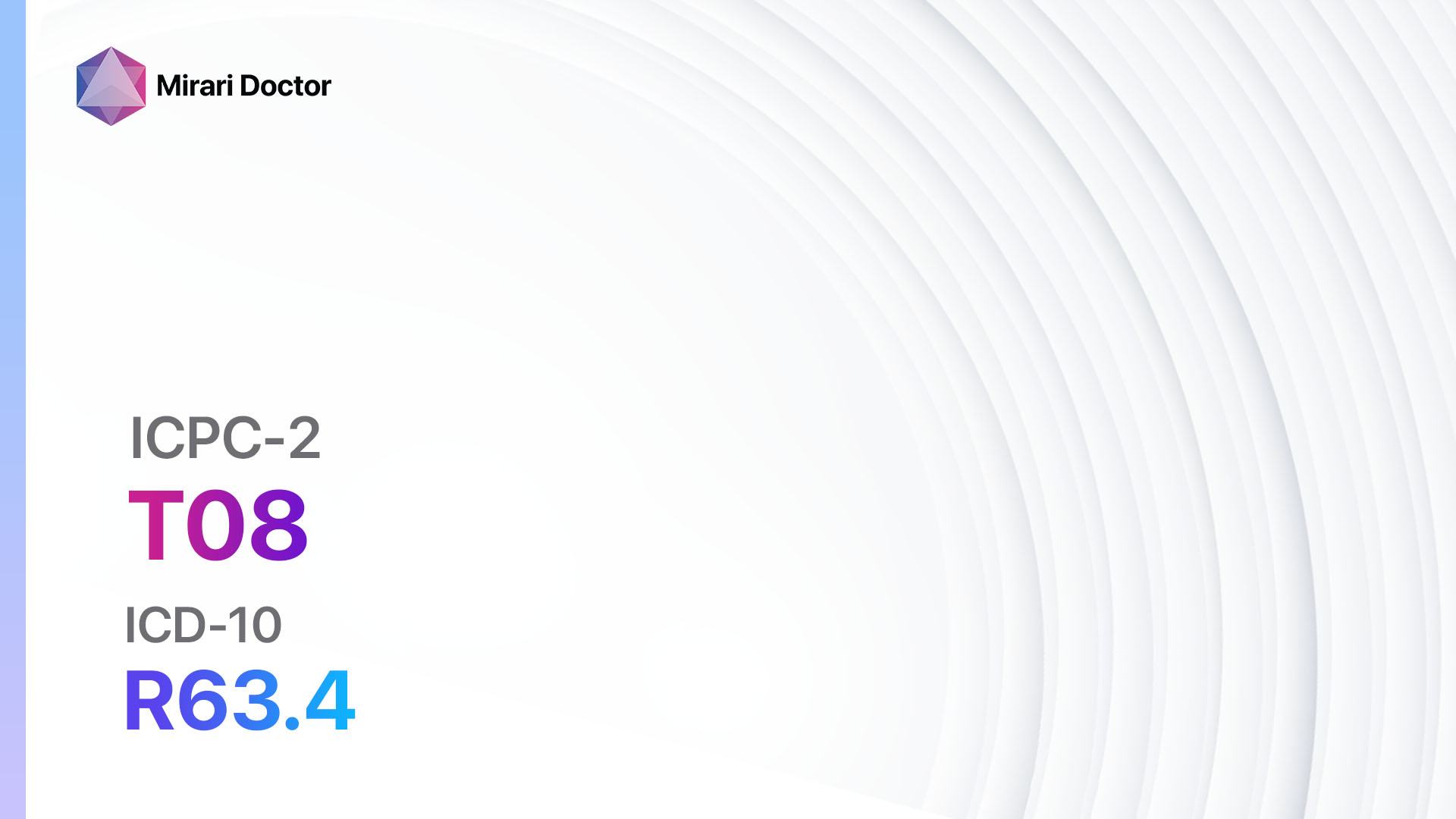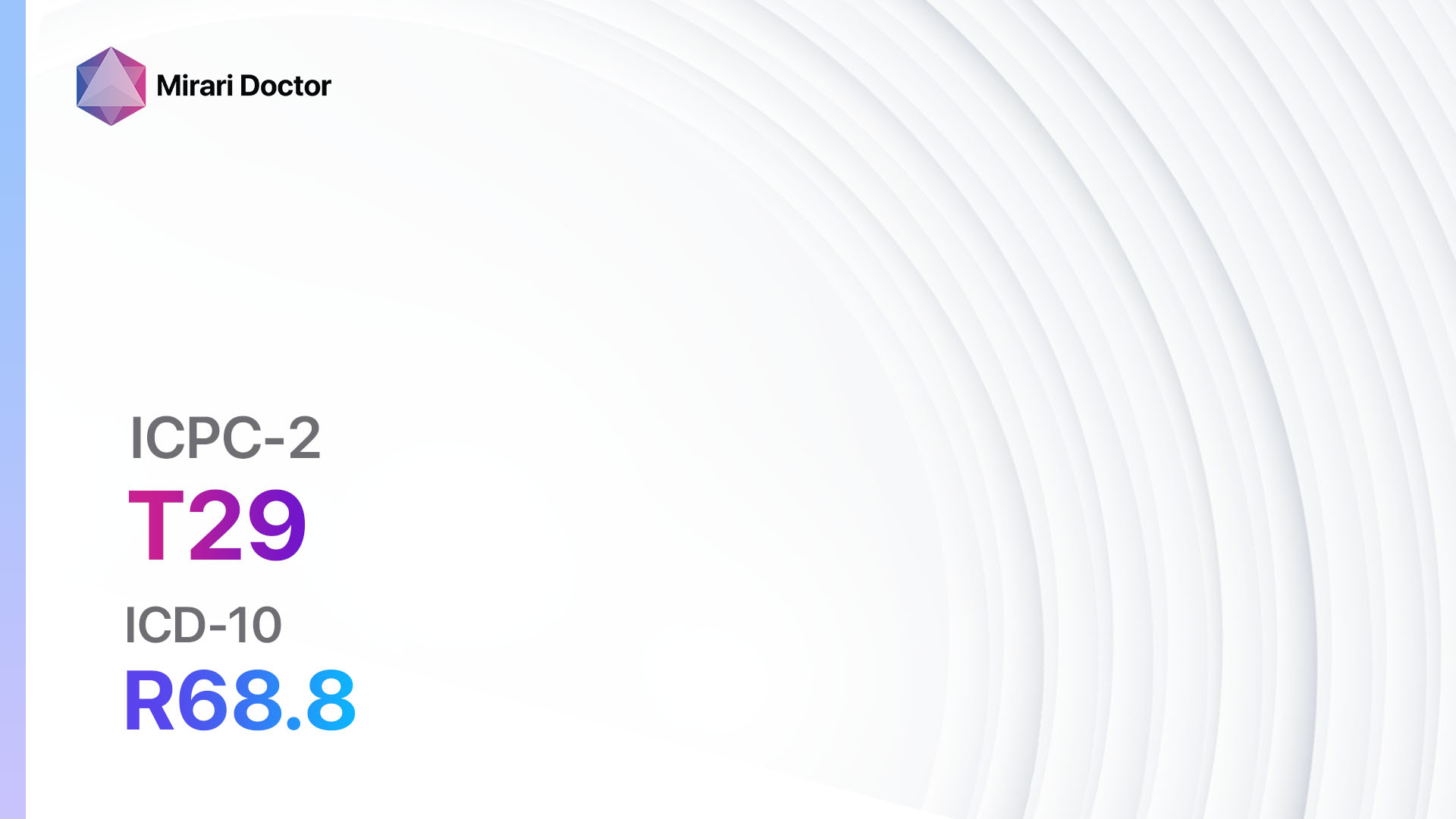
Introduction
Endocrine/met./sympt/complt other refers to a group of conditions that affect the endocrine system and present with various symptoms and complications. The aim of this guide is to provide an overview of the symptoms, causes, diagnostic steps, possible interventions, and lifestyle interventions for this condition.
Codes
- ICPC-2 Code: T29 Endocrine/met/sympt/complt other[1]
- ICD-10 Code: R68.8 Other specified general symptoms and signs[2]
Symptoms
- Fatigue: Feeling tired and lacking energy.
- Weight changes: Unexplained weight gain or loss.
- Mood changes: Mood swings, irritability, or depression.
- Changes in appetite: Increased or decreased appetite.
- Changes in sleep patterns: Insomnia or excessive sleepiness.
- Changes in libido: Decreased sexual desire.
- Changes in menstrual cycle: Irregular periods or changes in menstrual flow.
- Hair loss: Thinning or loss of hair.
- Dry skin: Skin that is dry, itchy, or flaky.
- Muscle weakness: Weakness or decreased muscle mass.
- Increased thirst and urination: Excessive thirst and frequent urination[3].
Causes
- Hormonal imbalances: Imbalances in hormone production or regulation.
- Autoimmune disorders: Conditions where the immune system mistakenly attacks the body’s own tissues.
- Tumors: Benign or malignant growths in the endocrine glands.
- Genetic factors: Inherited gene mutations that affect hormone production or regulation.
- Medications: Certain medications can disrupt the normal functioning of the endocrine system[4].
Diagnostic Steps
Medical History
- Gather information about the patient’s symptoms, including their duration and severity.
- Identify any risk factors, such as family history of endocrine disorders or exposure to certain medications or toxins.
- Assess the patient’s medical history, including any previous diagnoses or treatments related to endocrine disorders.[5]
Physical Examination
- Perform a thorough physical examination to assess for any physical signs or findings indicative of endocrine disorders.
- Check for any abnormalities in the size or shape of the endocrine glands.
- Evaluate the patient’s vital signs, including blood pressure, heart rate, and temperature.[6]
Laboratory Tests
- Blood tests: Measure hormone levels, blood glucose levels, and other relevant markers.
- Urine tests: Assess hormone levels, kidney function, and other parameters.
- Genetic testing: Identify any genetic mutations or abnormalities that may be contributing to the endocrine disorder.[7]
Diagnostic Imaging
- Ultrasound: Visualize the structure and size of the endocrine glands.
- CT scan or MRI: Provide detailed images of the endocrine glands and surrounding structures.
- Nuclear medicine scans: Assess the function of specific endocrine glands by using radioactive tracers.[8]
Other Tests
- Biopsy: Remove a small sample of tissue from an endocrine gland for further analysis.
- Stimulating or suppressing tests: Administer substances to stimulate or suppress hormone production to assess gland function.
- Endoscopy: Insert a flexible tube with a camera into the body to visualize the endocrine glands.[9]
Follow-up and Patient Education
- Schedule follow-up appointments to monitor the patient’s progress and adjust treatment if necessary.
- Provide education about the condition, including its causes, symptoms, and treatment options.
- Encourage the patient to ask questions and seek support from healthcare professionals or support groups.[10]
Possible Interventions
Traditional Interventions
Medications:
Top 5 drugs for Endocrine/met./sympt/complt other:
- Levothyroxine (used for hypothyroidism):
- Cost: Generic versions can be $4-$15/month.
- Contraindications: Untreated adrenal insufficiency, thyrotoxicosis.
- Side effects: Headache, nervousness, weight loss.
- Severe side effects: Chest pain, rapid or irregular heartbeat.
- Drug interactions: Antacids, iron supplements, calcium supplements.
- Warning: Regular monitoring of thyroid function is required.
- Metformin (used for type 2 diabetes):
- Cost: Generic versions can be $4-$20/month.
- Contraindications: Severe kidney or liver disease, alcoholism.
- Side effects: Nausea, diarrhea, stomach upset.
- Severe side effects: Lactic acidosis, allergic reactions.
- Drug interactions: Cimetidine, furosemide, beta-blockers.
- Warning: Regular monitoring of kidney function is required.
- Insulin (used for type 1 diabetes or severe type 2 diabetes):
- Cost: Varies depending on the type of insulin and administration method.
- Contraindications: Hypoglycemia unawareness, allergy to insulin.
- Side effects: Hypoglycemia, weight gain.
- Severe side effects: Severe hypoglycemia, allergic reactions.
- Drug interactions: Beta-blockers, ACE inhibitors, oral antidiabetic drugs.
- Warning: Regular monitoring of blood glucose levels is required.
- Corticosteroids (e.g., Prednisone, Hydrocortisone):
- Cost: Generic versions can be $4-$20/month.
- Contraindications: Active infections, systemic fungal infections.
- Side effects: Increased appetite, weight gain, mood changes.
- Severe side effects: Adrenal suppression, osteoporosis.
- Drug interactions: NSAIDs, anticoagulants, antidiabetic drugs.
- Warning: Long-term use can lead to adrenal insufficiency.
- Antithyroid medications (e.g., Methimazole, Propylthiouracil):
- Cost: Generic versions can be $4-$20/month.
- Contraindications: Severe liver disease, agranulocytosis.
- Side effects: Rash, nausea, joint pain.
- Severe side effects: Severe liver injury, agranulocytosis.
- Drug interactions: Beta-blockers, anticoagulants, lithium.
- Warning: Regular monitoring of liver function and blood cell counts is required.
Alternative Drugs:
- Growth hormone replacement therapy (e.g., Somatropin): Used for growth hormone deficiency.
- Bisphosphonates (e.g., Alendronate): Used for osteoporosis.
- Dopamine agonists (e.g., Bromocriptine): Used for hyperprolactinemia.
- Anti-androgens (e.g., Spironolactone): Used for hirsutism or androgen excess.
- Calcitonin (e.g., Calcitonin salmon): Used for hypercalcemia.
Surgical Procedures:
- Adrenalectomy: Surgical removal of one or both adrenal glands. Cost: $10,000 to $30,000.
- Thyroidectomy: Surgical removal of all or part of the thyroid gland. Cost: $10,000 to $30,000.
- Parathyroidectomy: Surgical removal of one or more parathyroid glands. Cost: $10,000 to $30,000.
Alternative Interventions
- Acupuncture: May help alleviate symptoms and improve overall well-being. Cost: $60-$120 per session.
- Herbal supplements: Certain herbs, such as ashwagandha and ginseng, may have potential benefits for balancing hormones. Cost: Varies depending on the specific supplement.
- Yoga and meditation: Can help reduce stress and improve hormonal balance. Cost: Varies depending on the location and instructor.
- Chiropractic care: May help improve nervous system function and hormone regulation. Cost: $50-$150 per session.
- Mind-body techniques: Techniques such as biofeedback and guided imagery may help manage symptoms. Cost: Varies depending on the specific technique and practitioner.
Lifestyle Interventions
- Healthy diet: Emphasize whole foods, fruits, vegetables, and lean proteins. Cost: Varies depending on food choices and dietary preferences.
- Regular exercise: Engage in aerobic exercise, strength training, and flexibility exercises. Cost: Varies depending on the type of exercise and access to facilities.
- Stress management: Practice relaxation techniques, such as deep breathing, meditation, or yoga. Cost: Varies depending on the specific technique and practitioner.
- Adequate sleep: Aim for 7-9 hours of quality sleep per night. Cost: Varies depending on sleep aids or therapies used.
- Avoidance of toxins: Minimize exposure to environmental toxins, such as pesticides and chemicals. Cost: Varies depending on lifestyle choices and access to toxin-free products.
It is important to note that the cost ranges provided are approximate and may vary depending on the location and availability of the interventions. It is recommended to consult with healthcare professionals for personalized treatment options and cost estimates.
Mirari Cold Plasma Alternative Intervention
Understanding Mirari Cold Plasma
- Safe and Non-Invasive Treatment: Mirari Cold Plasma is a safe and non-invasive treatment option for various skin conditions. It does not require incisions, minimizing the risk of scarring, bleeding, or tissue damage.
- Efficient Extraction of Foreign Bodies: Mirari Cold Plasma facilitates the removal of foreign bodies from the skin by degrading and dissociating organic matter, allowing easier access and extraction.
- Pain Reduction and Comfort: Mirari Cold Plasma has a local analgesic effect, providing pain relief during the treatment, making it more comfortable for the patient.
- Reduced Risk of Infection: Mirari Cold Plasma has antimicrobial properties, effectively killing bacteria and reducing the risk of infection.
- Accelerated Healing and Minimal Scarring: Mirari Cold Plasma stimulates wound healing and tissue regeneration, reducing healing time and minimizing the formation of scars.
Mirari Cold Plasma Prescription
Video instructions for using Mirari Cold Plasma Device – T29 Endocrine/met/sympt/complt other (ICD-10:R68.8)
| Mild | Moderate | Severe |
| Mode setting: 7 (Immunotherapy) Location: 1 (Sacrum) Morning: 15 minutes, Evening: 15 minutes |
Mode setting: 7 (Immunotherapy) Location: 1 (Sacrum) Morning: 30 minutes, Lunch: 30 minutes, Evening: 30 minutes |
Mode setting: 7 (Immunotherapy) Location: 1 (Sacrum) Morning: 30 minutes, Lunch: 30 minutes, Evening: 30 minutes |
| Mode setting: 7 (Immunotherapy) Location: 4 (Heart, Bile & Pancreas) Morning: 15 minutes, Evening: 15 minutes |
Mode setting: 7 (Immunotherapy) Location: 4 (Heart, Bile & Pancreas) Morning: 30 minutes, Lunch: 30 minutes, Evening: 30 minutes |
Mode setting: 7 (Immunotherapy) Location: 4 (Heart, Bile & Pancreas) Morning: 30 minutes, Lunch: 30 minutes, Evening: 30 minutes |
| Mode setting: 7 (Immunotherapy) Location: 7 (Neuro system & ENT) Morning: 15 minutes, Evening: 15 minutes |
Mode setting: 7 (Immunotherapy) Location: 1 (Sacrum) Morning: 30 minutes, Lunch: 30 minutes, Evening: 30 minutes |
Mode setting: 7 (Immunotherapy) Location: 1 (Sacrum) Morning: 30 minutes, Lunch: 30 minutes, Evening: 30 minutes |
| Mode setting: 7 (Immunotherapy) Location: 7 (Neuro system & ENT) Morning: 15 minutes, Evening: 15 minutes |
Mode setting: 7 (Immunotherapy) Location: 7 (Neuro system & ENT) Morning: 30 minutes, Lunch: 30 minutes, Evening: 30 minutes |
Mode setting: 7 (Immunotherapy) Location: 7 (Neuro system & ENT) Morning: 30 minutes, Lunch: 30 minutes, Evening: 30 minutes |
| Total Morning: 60 minutes approx. $10 USD, Evening: 60 minutes approx. $10 USD |
Total Morning: 120 minutes approx. $20 USD, Lunch: 120 minutes approx. $20 USD, Evening: 120 minutes approx. $20 USD, |
Total Morning: 120 minutes approx. $20 USD, Lunch: 120 minutes approx. $20 USD, Evening: 120 minutes approx. $20 USD, |
| Usual treatment for 7-60 days approx. $140 USD – $1200 USD | Usual treatment for 6-8 weeks approx. $2,520 USD – $3,360 USD |
Usual treatment for 3-6 months approx. $5,400 USD – $10,800 USD
|
 |
|
Use the Mirari Cold Plasma device to treat Endocrine/met./sympt/complt other effectively.
WARNING: MIRARI COLD PLASMA IS DESIGNED FOR THE HUMAN BODY WITHOUT ANY ARTIFICIAL OR THIRD PARTY PRODUCTS. USE OF OTHER PRODUCTS IN COMBINATION WITH MIRARI COLD PLASMA MAY CAUSE UNPREDICTABLE EFFECTS, HARM OR INJURY. PLEASE CONSULT A MEDICAL PROFESSIONAL BEFORE COMBINING ANY OTHER PRODUCTS WITH USE OF MIRARI.
Step 1: Cleanse the Skin
- Start by cleaning the affected area of the skin with a gentle cleanser or mild soap and water. Gently pat the area dry with a clean towel.
Step 2: Prepare the Mirari Cold Plasma device
- Ensure that the Mirari Cold Plasma device is fully charged or has fresh batteries as per the manufacturer’s instructions. Make sure the device is clean and in good working condition.
- Switch on the Mirari device using the power button or by following the specific instructions provided with the device.
- Some Mirari devices may have adjustable settings for intensity or treatment duration. Follow the manufacturer’s instructions to select the appropriate settings based on your needs and the recommended guidelines.
Step 3: Apply the Device
- Place the Mirari device in direct contact with the affected area of the skin. Gently glide or hold the device over the skin surface, ensuring even coverage of the area experiencing.
- Slowly move the Mirari device in a circular motion or follow a specific pattern as indicated in the user manual. This helps ensure thorough treatment coverage.
Step 4: Monitor and Assess:
- Keep track of your progress and evaluate the effectiveness of the Mirari device in managing your Endocrine/met./sympt/complt other. If you have any concerns or notice any adverse reactions, consult with your health care professional.
Note
This guide is for informational purposes only and should not replace the advice of a medical professional. Always consult with your healthcare provider or a qualified medical professional for personal advice, diagnosis, or treatment. Do not solely rely on the information presented here for decisions about your health. Use of this information is at your own risk. The authors of this guide, nor any associated entities or platforms, are not responsible for any potential adverse effects or outcomes based on the content.
Mirari Cold Plasma System Disclaimer
- Purpose: The Mirari Cold Plasma System is a Class 2 medical device designed for use by trained healthcare professionals. It is registered for use in Thailand and Vietnam. It is not intended for use outside of these locations.
- Informational Use: The content and information provided with the device are for educational and informational purposes only. They are not a substitute for professional medical advice or care.
- Variable Outcomes: While the device is approved for specific uses, individual outcomes can differ. We do not assert or guarantee specific medical outcomes.
- Consultation: Prior to utilizing the device or making decisions based on its content, it is essential to consult with a Certified Mirari Tele-Therapist and your medical healthcare provider regarding specific protocols.
- Liability: By using this device, users are acknowledging and accepting all potential risks. Neither the manufacturer nor the distributor will be held accountable for any adverse reactions, injuries, or damages stemming from its use.
- Geographical Availability: This device has received approval for designated purposes by the Thai and Vietnam FDA. As of now, outside of Thailand and Vietnam, the Mirari Cold Plasma System is not available for purchase or use.
References
- ICPC-2 – English. ICPC-2 – English. (n.d.). Retrieved from https://www.gesy.org.cy/el-gr/annualreport/icpc-2-english1-10.pdf
- ICD-10 Version:2019. (n.d.). Retrieved from https://icd.who.int/browse10/2019/en
- Endocrine Disorders: Types, Causes, Symptoms, and Treatments. (n.d.). WebMD. Retrieved from https://www.webmd.com/diabetes/endocrine-system-disorders
- Metabolic and Endocrine Disorders – Physiopedia. (n.d.). Retrieved from https://www.physio-pedia.com/Metabolic_and_Endocrine_Disorders
- Diagnosis, Evaluation, and Disability. (n.d.). NCBI. Retrieved from https://www.ncbi.nlm.nih.gov/books/NBK593673/
- Intellectual Disability: Definition, Symptoms, Traits, Causes, Treatment. (n.d.). Verywell Mind. Retrieved from https://www.verywellmind.com/intellectual-disability-definition-symptoms-traits-causes-treatment-5220629
- Irons, B. K. (n.d.). Endocrine and Metabolic Disorders. Retrieved from https://www.accp.com/docs/meetings/UT15/handouts/PPC15_Endocrine_Disorders_workbook.pdf
- New Insights and Potential Therapeutic Interventions in Metabolic Diseases. (2023). International Journal of Molecular Sciences, 24(12), 10342. Retrieved from https://www.ncbi.nlm.nih.gov/pmc/articles/PMC10342188/
- Endocrine Disorder Tests – Mercy. (n.d.). Retrieved from https://www.mercy.net/service/endocrine-disorder-tests/
- Patient Education: Endocrine and Metabolic Disorders. (n.d.). Retrieved from https://endocrinology.wustl.edu/patient-care/patient-education/endocrine-and-metabolic-disorders/
Related articles
Made in USA


